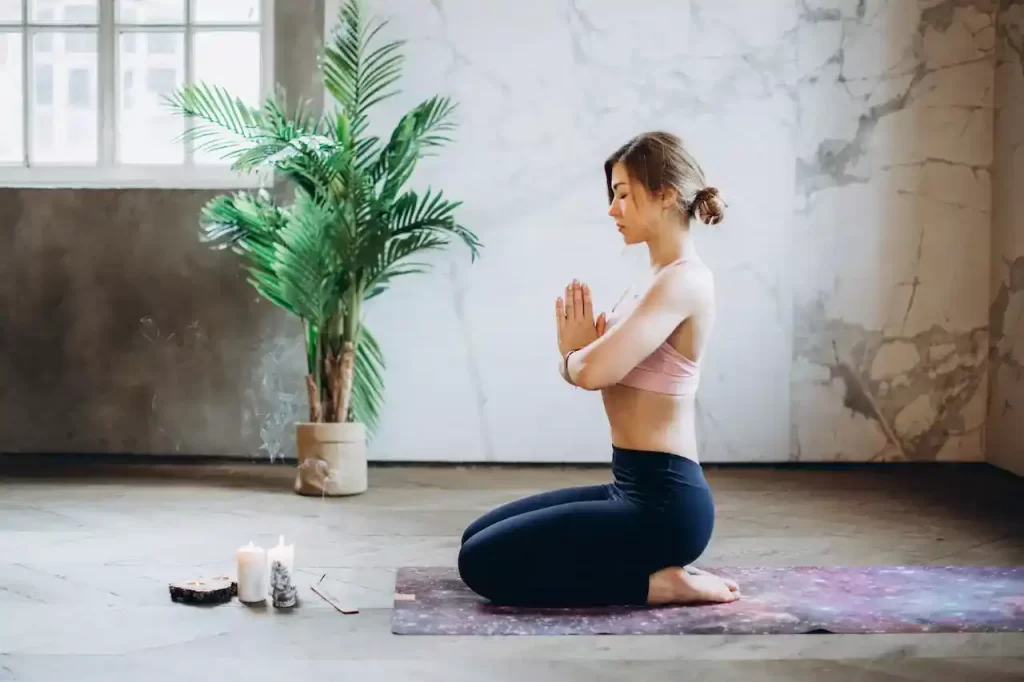It’s no secret that the world we live in can be overwhelming at times. We’re constantly bombarded with information, demands, and distractions that can leave us feeling anxious, stressed, and even angry. That’s why it’s more important than ever to find ways to calm our minds and focus on the present moment.
Enter mindfulness meditation. This practice has been around for thousands of years, but it’s only in recent decades that it’s become more popular in the Western world. And for good reason. Mindfulness meditation has been shown to have a wide range of benefits, from reducing stress and anxiety to improving sleep, boosting mood, and even enhancing our immune systems.
But what exactly is mindfulness meditation? At its core, it’s about paying attention to the present moment without judgment. This means focusing on our breath, our bodily sensations, and our thoughts as they arise, and simply observing them without getting caught up in them.
It may sound simple, but it’s not always easy. Our minds are wired to constantly jump from one thing to another, and it can be difficult to quiet the mental chatter and be fully present in the moment. That’s why mindfulness meditation is a practice – it takes time and effort to develop.
But the benefits are worth it. In a world that often feels chaotic and overwhelming, mindfulness meditation can help us find a sense of calm and inner peace. It can also help us make wiser choices, communicate more effectively, and cultivate a greater sense of compassion for ourselves and others.
So if you’re feeling stressed or overwhelmed, why not give mindfulness meditation a try? It may just be the key to unlocking a more peaceful, fulfilling life.
Find a comfortable spot to meditate
Alright, let’s get into the nitty-gritty of how to start your mindfulness meditation practice! The first step is finding a comfortable spot to meditate. This can really make or break your practice, so it’s important to take some time to find a spot that feels good to you.
Ideally, you want to find a spot that is quiet and free from distractions. Maybe it’s a corner of your bedroom, or a spot in your living room where you can set up some cushions. Whatever it is, make sure it’s a space where you feel comfortable and relaxed.
Some people like to use a meditation cushion or a yoga mat to sit on during their practice. Others prefer to sit in a chair or even lie down. There’s no right or wrong way to do it – the most important thing is that you feel comfortable and at ease.
If you’re new to meditation, it can be helpful to set up your spot in a way that feels intentional and calming. Maybe you want to light a candle or set up some plants around you. Whatever helps you get into the right headspace.
Finally, make sure you’re dressed in comfortable clothing and that you won’t be disturbed during your practice. Turn off your phone and let anyone around you know that you need some uninterrupted time to meditate. With these simple steps, you’ll be well on your way to a peaceful and productive meditation practice.
Close your eyes and pay attention to all the things your senses can identify
Now that you’ve found a comfortable position, it’s time to dive into the mindfulness meditation practice. Take a deep breath and close your eyes. The first thing you need to do is focus on your breath. Breathe in slowly, feel the air enter your lungs, and then exhale slowly. Do this for a few minutes until you feel calm and relaxed.
Now, start paying attention to all the things your senses can identify. What do you smell? Can you hear any sounds? What do you feel against your skin? Is there a taste in your mouth? Just let your senses do the work and observe everything without any judgment.
It’s normal for your mind to wander off during this process, but that’s okay. When you notice your thoughts drifting away, gently guide your attention back to your senses. Don’t beat yourself up for getting distracted. It’s a part of the process, and with time and practice, you’ll get better at it.
As you continue with this exercise, you’ll start to notice things that you hadn’t before. You might discover new scents or sounds that you’ve never paid attention to. This practice helps you stay present in the moment and aware of your surroundings.
This step in the mindfulness meditation practice is crucial because it helps you develop your senses and focus your attention. By paying attention to your senses, you’re training your brain to be more present and alert. This skill can be applied to all areas of your life, not just during meditation. You’ll find yourself being more aware of your surroundings, making better decisions, and being more productive.
Let go of what is happening outside and focus on your breath
Now that you’ve taken the time to ground yourself and become more aware of your surroundings, it’s time to really hone in on your breath. This step is all about letting go of any external distractions and focusing solely on your breathing.
Start by taking a deep breath in, filling up your lungs completely, and then exhaling slowly. Continue to do this for a few breaths, really focusing on the sensation of the air moving in and out of your body. Notice the rise and fall of your chest, the sound of the air moving through your nostrils, and the feeling of your breath as it passes over your lips.
As you continue to breathe, you may find that your mind starts to wander. This is completely normal and expected! Our minds are naturally inclined to jump from thought to thought, so don’t beat yourself up if you find yourself getting distracted. Simply acknowledge the thought and then bring your focus back to your breath.
You may also notice that your breath starts to slow down and become more rhythmic as you continue to focus on it. This is a good sign! Slower, deeper breathing can help to calm your nervous system and reduce feelings of anxiety and stress.
Remember, the goal of this step is not to control your breath or force it to be a certain way. Rather, it’s simply about bringing your attention to your breath and allowing it to flow naturally. With time and practice, you may find that your breathing becomes a powerful tool for relaxation and mindfulness.
Focus on all aspects of your breath to go deeper
When we first start meditating, we often focus solely on the sensation of our breath going in and out of our nose. However, as we progress in our practice, we can start paying attention to all aspects of our breath, such as the sensation of the air moving in and out of our nostrils, the rise and fall of our chest or belly, and the pauses between each inhale and exhale.
By focusing on all these aspects, we can deepen our concentration and enhance our awareness of the present moment. It also allows us to tune out other distractions and thoughts that may arise during meditation.
It’s important to remember that mindfulness meditation is not about stopping our thoughts altogether, but rather acknowledging them and letting them go. The same goes for distractions during meditation. Instead of getting frustrated, simply acknowledge them and bring your focus back to your breath.
The more we practice mindfulness meditation, the easier it becomes to focus on all aspects of our breath and the present moment. This can lead to a greater sense of calm and relaxation in our daily lives, as well as increased awareness and focus.
So, in summary, Step 4 of mindfulness meditation involves focusing on all aspects of our breath to deepen our concentration and enhance our awareness of the present moment. Remember to acknowledge any distractions or thoughts that arise and bring your focus back to your breath. With practice, you’ll be able to achieve a deeper sense of peace and mindfulness in your life.
Become aware of the thoughts you have and let them go
Many people believe that the goal of meditation is to completely clear the mind of all thoughts. However, this is not entirely true. The true goal is to become aware of your thoughts without becoming attached to them or allowing them to control your emotions and actions.
As you meditate, you may find that thoughts naturally arise in your mind. These thoughts may be related to your daily life, your worries, your to-do list, or anything else. When this happens, do not try to forcefully push the thoughts away or judge yourself for having them. Instead, simply observe them without judgment and let them go.
One technique that can help you let go of your thoughts is to imagine them as clouds floating by in the sky. As each thought arises, visualize it as a cloud passing by and simply observe it without becoming attached. Then, let it drift away and bring your attention back to your breath.
It is important to note that letting go of thoughts is a skill that takes time and practice to develop. Be patient with yourself and do not become discouraged if you find yourself getting caught up in your thoughts. Simply acknowledge it and gently bring your focus back to your breath.
Incorporating this step into your mindfulness meditation practice can have a profound impact on your mental and emotional wellbeing. By learning to let go of your thoughts, you can cultivate a sense of inner peace and clarity that can positively impact every aspect of your life.
Conclusion
Congratulations! You’ve made it through all the steps of mindfulness meditation. By now, you’ve become aware of the many benefits of this practice, including reduced stress and anxiety, improved focus, and increased self-awareness. But, as with any habit, consistency is key. To truly experience the benefits of mindfulness meditation, you need to make it a part of your daily routine.
Just like going to the gym or eating healthy, mindfulness meditation requires dedication and effort. It can be tempting to skip a day or two, especially if you don’t feel like you have the time, but it’s essential to make it a priority. Even if you can only spare a few minutes a day, it’s better than nothing.
To help with consistency, it’s important to find a time and place that works for you. Whether it’s first thing in the morning or before bed, find a time that you can commit to every day. And make sure your environment is conducive to meditation. Find a quiet place where you won’t be disturbed, and consider using props like a cushion or a blanket to make yourself comfortable.
Remember, mindfulness meditation is a journey, not a destination. It’s not something that you can perfect overnight, so don’t get discouraged if you don’t see immediate results. Like any new habit, it takes time and practice to get better. Be patient and kind to yourself as you develop your meditation practice.
In the end, the benefits of mindfulness meditation are undeniable. By taking the time to be present in the moment, you’ll find that your mind is clearer, your body is more relaxed, and your emotions are more balanced. So go ahead, give it a try, and see how mindfulness meditation can transform your life.





